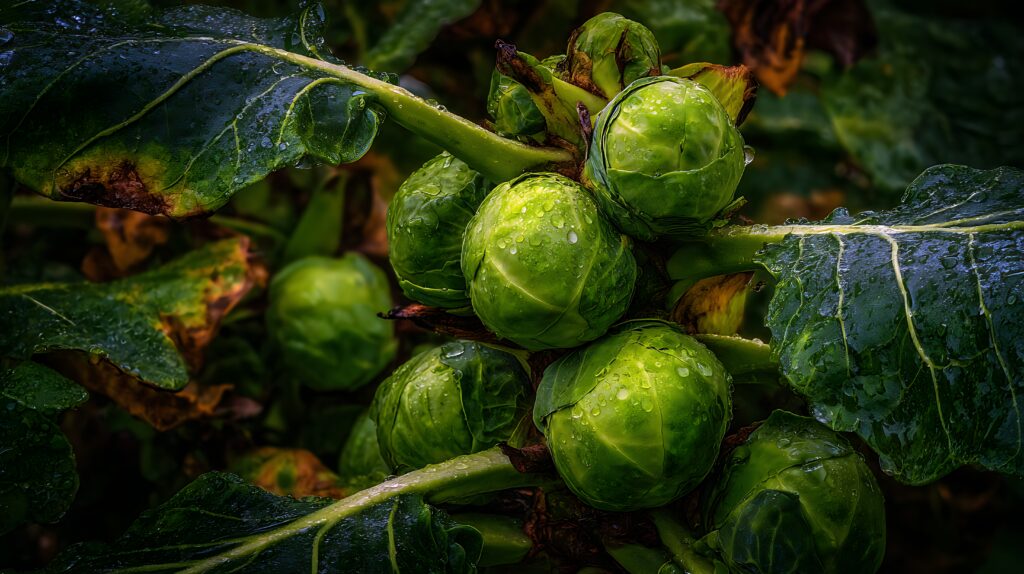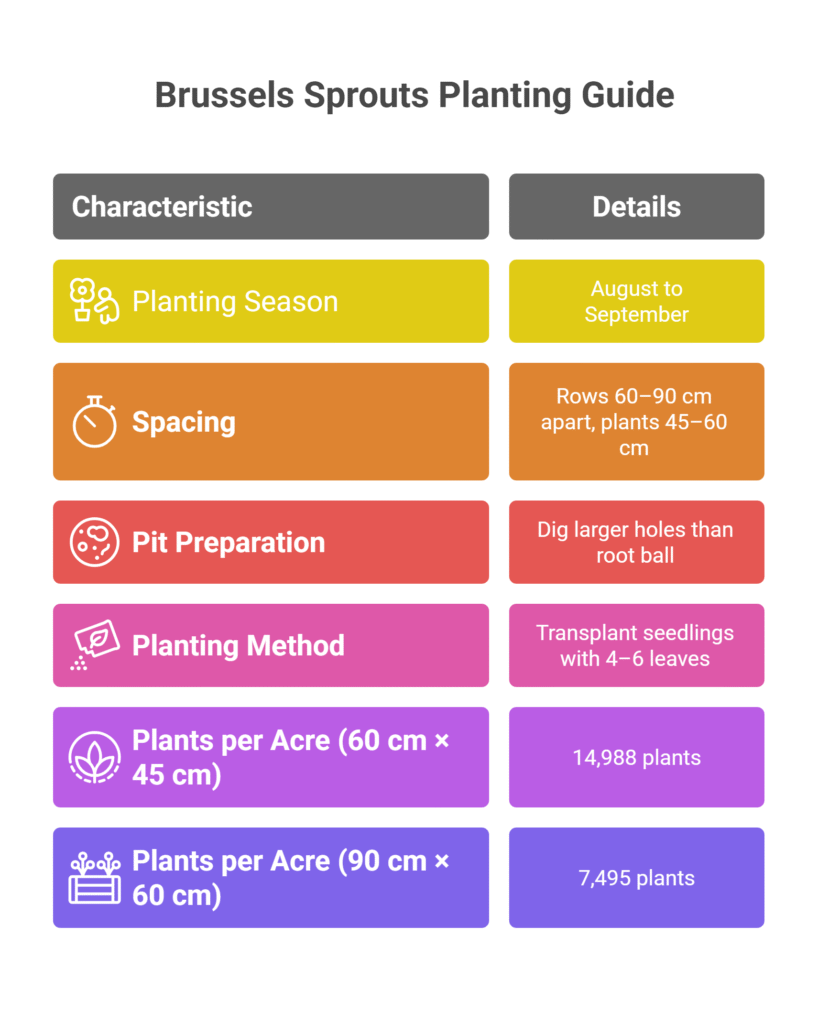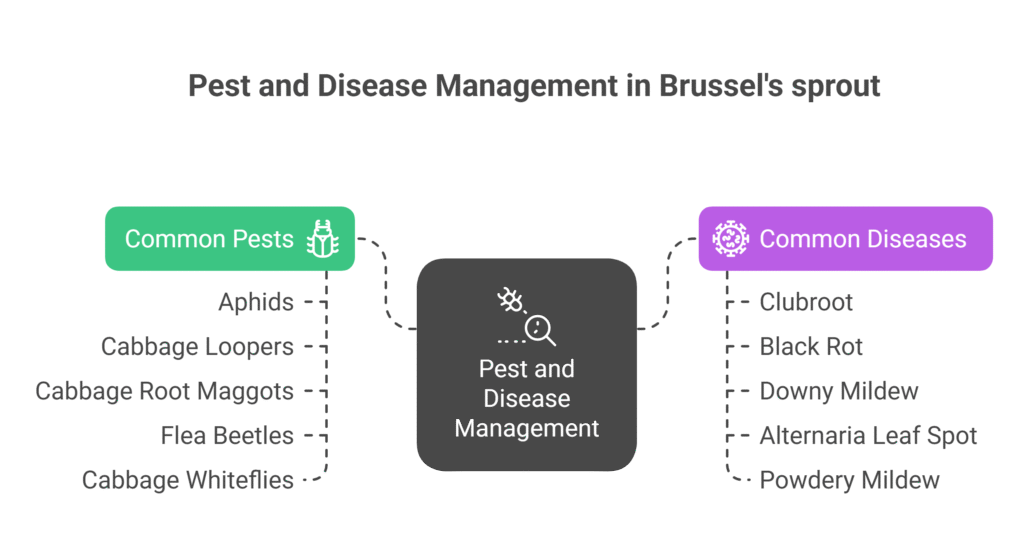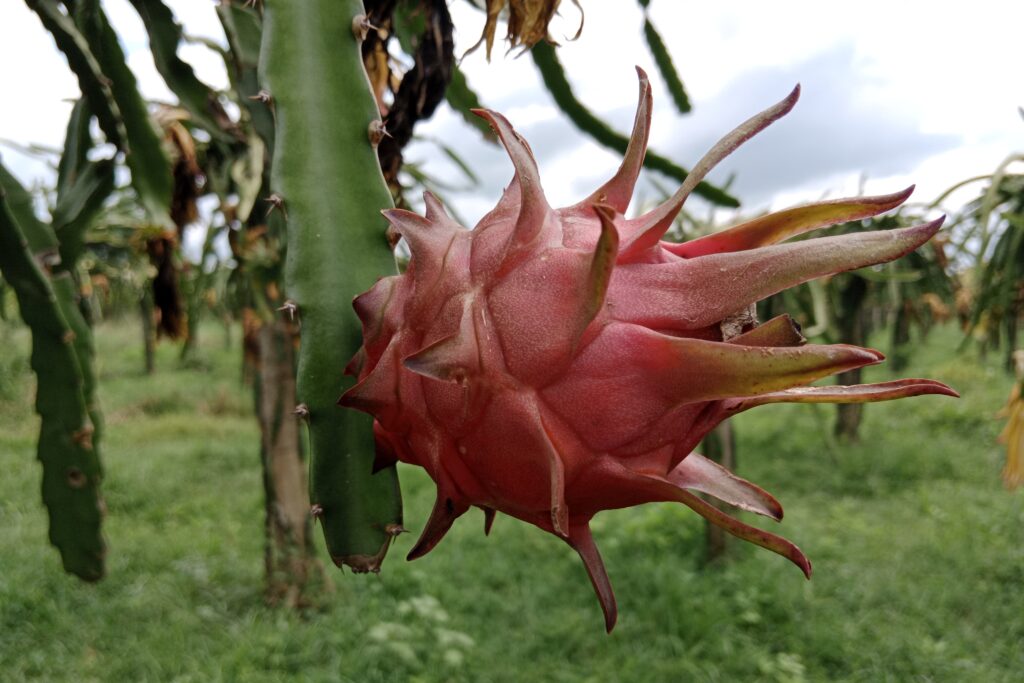Brussels Sprout Farming
Brussels sprout (Brassica oleracea var. gemmifera) is a cool-season vegetable belonging to the cabbage family, distinguished by its small, cabbage-like buds that form along a tall upright stem. The plant can grow up to about one meter in height, producing numerous compact sprouts tightly arranged on its stalk. Rich in essential vitamins, minerals, and antioxidants, it is valued for its high nutritional content and unique taste, making it increasingly popular in fresh markets and widely used in various culinary dishes worldwide.

For agricultural entrepreneurs seeking a high-value cash crop, Brussels sprout cultivation presents an exceptionally lucrative opportunity. A detailed financial breakdown reveals that Brussels sprout farming profit per acre is remarkably high, with farmers earning a substantial net profit of NRs. 181,000 from a total income of NRs. 240,000 against a relatively modest initial investment of just NRs. 59,000.
This venture offers an impressive Return on Investment (ROI) of 306.8%, meaning it generates more than three times the initial capital outlay. Bolstered by a robust profit margin of 75.4% and a highly favorable benefit-cost ratio, Brussels sprout farming stands out as a premier and highly rewarding agribusiness venture when managed with efficiency and proper agricultural practices.

Land Preparation
Land preparation aims to create a deep, well-drained, and weed-free seedbed with good tilth, ensuring optimal conditions for crop establishment. The process involves deep plowing (8–12 inches) to loosen the subsoil and incorporate crop residues, followed by several rounds of harrowing or discing to break down clods and level the field. At this stage, well-rotted manure or compost should be incorporated to enrich the soil, and in regions with heavy rainfall or poor drainage, raised beds are recommended to prevent waterlogging and promote healthy root development.
Soil Type
This crop thrives in deep, fertile, well-drained soils like sandy loam, loam, or silt loam, preferring a pH between 6.0 and 6.8; it performs poorly in acidic soils below pH 6.0 but tolerates slight alkalinity, and adequate drainage is essential to prevent excess moisture, which stunts growth and promotes diseases like clubroot, making unamended, poorly drained heavy clay soils generally unsuitable.
Climatic Requirements
This cool-season crop thrives in mean temperatures of 15–20°C (59–68°F) and requires a long, cool growing period of about 90–120 days after transplanting. While it can tolerate light frosts, which often enhance sweetness and quality, exposure to high summer heat above 26°C (79°F) leads to loose, bitter sprouts and premature bolting. The crop grows best in full sun, needing at least six hours of direct sunlight daily, and consistent soil moisture is crucial for healthy growth, though waterlogging should be avoided.

Major Cultivars
Major cultivars of Brussels sprouts are selected based on factors such as maturity period (early, mid, or late), sprout size and quality, plant uniformity, cold tolerance, and resistance to diseases. Popular examples include ‘Long Island Improved’, a classic cold-hardy type; ‘Jade Cross’ and ‘Jade Cross E’, known for their compact growth and disease resistance; ‘Oliver’, valued for its early maturity and uniform sprouts; ‘Diablo’, a vigorous variety offering an extended harvest; ‘Churchill’, a reliable mid-season cultivar; and novelty types like ‘Red Bull’ and ‘Rubine’, which produce attractive purple to red sprouts.
Propagation
The plant is propagated almost exclusively by seeds, which are typically started indoors in a greenhouse or protected nursery environment approximately 5 to 7 weeks before the intended outdoor transplanting date. This method is strongly preferred over direct seeding in the field due to the plant’s characteristically slow initial growth, which makes it highly vulnerable to intense weed competition and necessitates the precise spacing achieved by transplanting young seedlings.
Seed Rate per Acre
Due to the standard practice of nursery raising and transplanting, the actual seed rate required per acre is relatively low, typically ranging from just 200 to 300 grams; this modest amount accounts for standard germination rates and is sufficient for producing the necessary quantity of robust, healthy seedlings for transplantation.
Nursery Management
Nursery management for Brussels sprouts begins with sowing seeds ¼ to ½ inch deep in a sterile seed-starting mix. For successful germination, maintain an ideal temperature of 18–24°C (65–75°F), a process which typically takes 4–7 days. Once sprouts appear, this temperature should be reduced to 15–18°C (60–65°F) to encourage sturdy, healthy development.
Strong light is absolutely essential to prevent weak, leggy seedlings, and consistent moisture must be managed carefully to avoid waterlogging. To minimize disease risk, avoid late-day overhead watering. Finally, before moving them to the garden, seedlings must be hardened off over 7–10 days by gradually introducing them to outdoor elements like sun, wind, and cooler temperatures to reduce transplant shock.
Planting
Planting Season
In warmer climates, Brussels sprouts typically grown as a fall or winter crop. Transplanting is done in August to September (late summer to early fall), so that the plants mature during the cool weather of October to December when sprout quality is highest.
Spacing
Brussels sprouts grow best with plenty of room. Keep rows 60–90 cm apart and place each plant 45–60 cm from the next to allow for air flow and proper growth.

Pit Preparation
Dig holes slightly larger than the transplant root ball at the marked spacing.
Planting Method
Brussels sprouts should be transplanted once seedlings are hardened off and have developed 4–6 true leaves, planting them slightly deeper than they were in the nursery tray, up to the first set of true leaves, to encourage stronger stem growth. The soil should be gently firmed around the roots, and plants must be watered thoroughly immediately after planting to ensure proper establishment.
Number of Plants per Acre
| Spacing (Row × Plant) | Number of Plants per Acre |
| 60 cm × 45 cm | 14,988 plants |
| 90 cm × 60 cm | 7,495 plants |
Intercropping
Brussels sprouts can be intercropped with quick-maturing, low-growing crops such as lettuce, radishes, spinach, or bush beans early in the season before their canopy closes, but caution is needed to avoid heavy feeders or tall crops that compete for light, water, and nutrients; while intercropping is possible with proper spacing, it is not always recommended if the goal is to maximize sprout yield.
Irrigation
Irrigation is critical for Brussels sprouts, as consistent soil moisture is essential, especially during sprout formation. Drought stress can lead to small, tough, or poorly filled sprouts, affecting overall yield and quality.
Recommended methods include drip irrigation, which is highly efficient and helps keep foliage dry, reducing the risk of diseases. Overhead sprinklers can also be used, but they may increase the likelihood of foliar diseases.
Watering should be done consistently and thoroughly, supplying around 1–1.5 inches of water each week, while taking into account rainfall, soil type, and temperature. Avoid overwatering, as waterlogged soil can harm the roots and restrict healthy plant development.
Fertilizer and Manure for Brussels Sprouts
Fertilizer and Manure for Brussels Sprouts: Brussels sprouts are high-nutrient crops that require generous fertilization for optimal growth. Nitrogen (N) supports robust leafy development, while Phosphorus (P) strengthens the root system. Conducting a soil test beforehand is advised to apply the appropriate amounts of nutrients.
| Application Type | Materials & Quantities | Timing & Notes |
| Basal Application (Applied during land preparation) | • Well-rotted FYM/Compost: 10-15 tons/acre • Balanced NPK Fertilizer: 60-80 kg N, 60-80 kg P₂O₅, 60-80 kg K₂O per acre • Biofertilizers: Azospirillum, PSB (Phosphate Solubilizing Bacteria), and Potash Mobilizing Bacteria (800g of each per acre) | Incorporate all materials thoroughly into the soil before planting. |
| Top Dressing | • Nitrogen (N): 30-50 kg/acre | First Application: 4-6 weeks after transplanting. Second Application: When sprout buds begin to form. Note: Avoid excessive late nitrogen as it delays maturity and reduces sprout firmness. |
Weed Control
Effective weed control is crucial for Brussels sprouts, as weeds aggressively compete for essential water, nutrients, and light, particularly during the crop’s slow-growing early stages. A successful strategy integrates multiple methods: applying organic mulch like straw or compost to suppress weeds and conserve soil moisture, performing careful shallow cultivation to avoid damaging the plants’ shallow roots, and conducting necessary hand weeding directly around the plant base.
While pre-plant or pre-emergent herbicides can be used with strict adherence to label instructions, post-emergent options are limited, making diligent physical and cultural weed management practices the cornerstone of an effective program.
Interculture Operation
Interculture operations for Brussels sprouts include staking and pruning to support plant health and optimize sprout development. Tall varieties or plants grown in windy areas may require staking for stability. Pruning involves gradually removing lower leaves (1–2 per week) as sprouts form on the stem to improve air circulation and ease harvesting, while keeping the healthy upper leaves intact.
Topping the plant, performed about 3–4 weeks before the planned harvest, involves pinching out the apical bud to halt upward growth and direct energy into enlarging and maturing existing sprouts, which is particularly important for single-harvest mechanical harvesting.
Flowering and Fruit Management
Brussels sprouts are biennial plants, with the edible portion being the lateral buds rather than flowers or fruits. Premature flowering, or bolting, can occur if young plants experience cold temperatures (vernalization) or stress from heat or drought, which can ruin the crop.
To prevent this, growers should select bolt-resistant cultivars and plant at the appropriate time for their climate. Fruit management is not applicable; the focus should remain on preventing bolting and properly managing the sprout buds.
Pest and Disease Management
Common Pests
a). Aphids
Sap is what aphids eat, weakening plants and spreading infections. They can be managed by applying a thorough foliar spray of neem oil (2–3 ml per liter of water) or insecticidal soap (2–3% solution). Ladybugs and lacewings are examples of beneficial insects that naturally lower aphid numbers.
b). Cabbage Loopers and Imported Cabbage Worms
These pests chew on leaves and sprouts, causing significant damage. Management includes applying Bacillus thuringiensis (Bt) at 2–3 g per liter of water or spinosad at 0.5–1 ml per liter, along with hand-picking larvae and using row covers to prevent infestation.
c). Cabbage Root Maggots
Larvae feed on roots, stunting growth or killing seedlings. Preventive measures include placing collars around seedlings and applying beneficial nematodes. Chemical control can involve chlorpyrifos 20 EC at 2 ml per liter applied to the soil around the base of seedlings.
d). Flea Beetles
Flea beetles cause shot-hole damage on leaves, especially seedlings. They can be managed using carbaryl 50 WP at 2 g per liter or cypermethrin 10 EC at 1 ml per liter, along with protective row covers and diatomaceous earth.
e). Cabbage Whiteflies
These sap-sucking insects may also lead to sooty mold. Control measures include spraying insecticidal soap at 2–3% solution or imidacloprid 17.8 SL at 0.3–0.5 ml per liter, and using yellow sticky traps to monitor and reduce populations.

Common Diseases
Clubroot
Clubroot (caused by Plasmodiophora brassicae) is a severe soil-borne disease that causes swollen, misshapen roots and severely stunts plant growth. Since there is no effective chemical cure, prevention is essential.
Key strategies include practicing very long crop rotations (4–7 years without brassicas), raising soil pH to at least 7.0 through liming, using resistant cultivars, and ensuring all transplants and equipment are free of contaminated soil.
For preventative chemical control, soil drenches with pentachloronitrobenzene (PCNB) can be applied at 5 g/m² incorporated into the soil at planting, though this will not cure existing infections and should be used according to label instructions.
b) Black Rot
Black rot, caused by Xanthomonas campestris pv. campestris, is a serious bacterial disease characterized by V-shaped yellowing along the leaf edges. Since conventional fungicides are ineffective, control relies entirely on cultural practices.
Important measures include using certified disease-free seeds, rotating crops, avoiding fieldwork when plants are wet, preventing overhead irrigation, and quickly removing and destroying infected plants.
Preventative applications of copper-based bactericides, such as copper hydroxide or copper oxychloride, at 2–3 g/L water as a foliar spray can help suppress the disease under favorable conditions, but they will not eliminate established infections.
c) Downy Mildew
Downy mildew, caused by Hyaloperonospora parasitica, appears as a fuzzy, gray-white growth on the undersides of leaves. Effective control focuses on reducing leaf wetness and humidity by improving air circulation through proper plant spacing, watering at the base, and avoiding overhead irrigation.
For chemical prevention under cool, moist conditions, protectant fungicides such as chlorothalonil at 2 g/L or mancozeb at 2.5 g/L can be applied, while systemic options like metalaxyl at 2 g/L or fosetyl-Al at 3 g/L are also effective. Alternating chemical classes is recommended to prevent resistance.
d) Alternaria Leaf Spot
Alternaria leaf spot, caused by Alternaria spp., manifests as dark brown to black lesions with concentric rings and may result in early leaf drop. Control measures include clearing and destroying infected crop residues at the end of the season and practicing a crop rotation away from brassicas for at least two years.
Fungicide applications should begin at the first appearance of symptoms, using effective options such as chlorothalonil at 2 g/L, azoxystrobin at 0.5 g/L, or boscalid at 0.5–1 g/L, while adhering to resistance management practices when applying systemic chemicals.
e) Powdery Mildew
Powdery mildew, caused by Erysiphe cruciferarum, appears as a white, powdery fungal coating on leaf surfaces, and planting resistant varieties remains the most effective long-term control strategy. If needed, fungicides should be applied at the first sign of symptoms, with effective options including sulfur-based products at 2–3 g/L, potassium bicarbonate at 5 g/L, or systemic fungicides such as myclobutanil at 0.5 g/L or triflumizole at 0.5 g/L.
Harvesting
Timing
Harvesting typically begins 90–120+ days after transplanting, with sprouts maturing from the bottom of the stalk upwards. Sprouts should be picked when they are firm, compact, bright green (or according to cultivar color), and 1–2 inches in diameter for the best quality.
Method
There are two main harvesting approaches. Selective picking is the most common method, involving twisting or snapping off the lower sprouts as they mature and progressing upward over several weeks. Leaves above each sprout can be removed along with it, and exposure to frost can enhance flavor. Single harvest is used for processing or efficiency, where plants are topped 3–4 weeks before harvest to promote uniform sprout maturity, and the entire stalk is cut at ground level once most sprouts are ready.
Handling
Careful handling is essential to prevent bruising. Harvested sprouts should be cooled immediately to preserve freshness and maintain quality.
Yield
Brussels sprouts typically produce a yield ranging from 3,500 to 5,500 kg per acre, depending on cultivar, growing conditions, and management practices.
Cost of Investment per Acre for Brussel’s sprout
| S.N. | Categories | Cost (NRs.) |
| 1 | Land Preparation (Plowing) | 15,000 |
| 2 | Seed | 2,000 |
| 3 | Nursery Management | 5,000 |
| 4 | Transplanting | 4,000 |
| 5 | Fertilizers and Manure | 10,000 |
| 6 | Irrigation | 5,000 |
| 7 | Weed Control (Pre & Post) | 3,000 |
| 8 | Pest & Disease Control | 3,000 |
| 9 | Harvesting | 7,000 |
| 10 | Miscellaneous Costs | 5,000 |
| Total Cost of Investment | 59,000 |
Income per acre for Brussels sprout
| Particulars | Estimated Yield / Acre (Kg) | Market Price (NRs./Kg) | Total Income (NRs.) |
| Yield | 4,000 | 60 | 240,000 |
Analysis of Brussels sprout farming profit per acre
| Metric | Calculation | Amount (NRs) |
| Total Income | 4,000 kg × NRs 60/kg | 240,000 |
| Total Investment | (Sum of all costs) | 59,000 |
| Net Profit | Income – Investment | 181,000 |
| Profit Margin | (Net Profit / Income) × 100 | 75.4% |
| Return on Investment (ROI) | (Net Profit / Investment) × 100 | 306.8% |
Brussel’s sprout farming is highly profitable, yielding a net profit of NRs. 181,000 per acre from a total income of NRs. 240,000 against an investment of NRs. 59,000. With an exceptional ROI of 306.8%, farmers earn over three times their investment, while a strong profit margin of 75.4% and a benefit–cost ratio above 4 highlight its excellent returns, making it a highly rewarding crop when managed effectively.
Crop Calendar for Brussels sprout
| Phase | When? | What To Do? | Key Points to Remember |
| Planning & Nursery | June – July | • Start seeds indoors in trays. • Prepare the main field. | • Seeds need warmth (18-24°C) to sprout. • Add compost or manure to the soil during preparation. |
| Transplanting | Late August | • Move young plants to the field. | • Wait until plants have 4-6 true leaves. • Give plants space: 45-60 cm apart in rows 60-90 cm apart. • Water them well right after planting. |
| Early Growth | September | • Water regularly. • Control weeds. • Watch for pests. | • Keep soil moist but not soggy. Drip irrigation is best. • Use mulch to stop weeds. • Look for bugs like flea beetles and aphids. |
| Active Growth | October – November | • Add fertilizer (Top Dressing). • Continue pest control. • Remove some lower leaves. | • Add nitrogen fertilizer 4-6 weeks after planting. • Add more nitrogen when small sprouts appear. • Removing a few leaves helps air flow and makes harvesting easier. |
| Harvesting | December – February | • Pick sprouts from the bottom up. | • Harvest when sprouts are firm, green, and 1-2 inches wide. • A little frost makes them taste sweeter. • Handle gently to avoid bruising. |
| After Harvest | After all sprouts are picked | • Clean up the field. • Plan next year’s crop. | • Remove old plant debris to reduce diseases. • Do not plant cabbage, broccoli, or cauliflower here next year. Rotate with a different |
Sources
Food and Agriculture Organization (FAO)
University of California Agriculture & Natural Resources (UC ANR)
European Plant Protection Organization (EPPO)
Punjab Agricultural University (PAU)
Tamil Nadu Agriculture University (TNAU) – Agritech portal
Indian Council of Agricultural Research (ICAR)
Nepal Agricultural Research Council (NARC)
U.S. Department of Agriculture (USDA).
Ministry of Agriculture and Livestock Development (Nepal).
Disclaimer: This crop farming profits assume optimal conditions. Actual results may vary depending on climate, market prices, and farm management practices.



Pingback: Squash Farming Profit Per Acre -